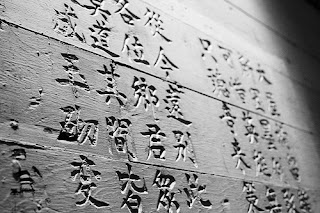 Source: Hoobler, Dorothy and Thomas. The Chinese American Family Album. Oxford University Press: New York, 1994. pg. 44-45.
Source: Hoobler, Dorothy and Thomas. The Chinese American Family Album. Oxford University Press: New York, 1994. pg. 44-45.
What is your name?
Leong Sem.
Has your house in China two outside doors?
Yes.
Who lives opposite the small door?
Leon Doo Wui, a farmer in the village; he lives with his wife, no one else.
Describe his wife.
Chine Shee, natural feet.
Didn't that man ever have any children?
No.
How old a man is he?
About 30.
Who lives in the first house in your row?
Leong Yik Fook, farmer in the village; he lives with his wife, no one else.
How many houses in your row?
Two.
Who lives in the first house, first row from the head?
Yik Haw, I don't know what clan he belongs to.
Why don't you know what clan he belongs to?
I never heard his family name.
Do you expect us to believe that you lived in that village if you don't know the clan names of the people living?
He never told us his family name.
How long has he lived in the village?
For a long time.
Who lives in the first house, third row?
Leong Yik Gai; he is away somewhere; he has a wife, onse son and a adaughter living in that house.
According to your testimony today there are only five houses in the village and yesterday you said there were nin.
There are nine houses.
Where are the other four?
There us Doo Chin's house, first house, sixth row.
What is the occupation of Leong Doo Chin?
He has no occupation; he has a wife, no children.
Describe his wife. Ng Shee, bound feet.
Who is another of those four families you haven't mentioned?
Leong Doo Sin.
Where is his house?
First house, fourth row.
There are two [other] families, who are they and where do they live?
Chin Yick Dun, fifth row, third house.
What is his occupation?
No occupation.
What family has he?
He has a wife and a son; his wife is Chin Shee, natural feet.
Did you ever hear of a man of the Chin family marrying a Chin family woman?
[This was forbidden by Chinese custom.] I made a mistake; her husband is Leong Yick Don.
What is the name and age of that son?
Leong Yik Gai; his house is first house, fourth row.
You have already put Leong Doo Sin in the fourth row, first house. His house is first house, third row. You have already put Leong Yick Gai first house, third row. I am mixed up.
This sample interrogation clearly shows the difficult and overly specific questions asked by the interrogators. The questions were very unrelated to actually gaining citizenship: their primary function was to limit Chinese citizenship as much as possible.
For more information, go to www.chineseamericanstories.blogspot.com/p/angel-island-immigration-station.html and Angel Island Immigration Station


